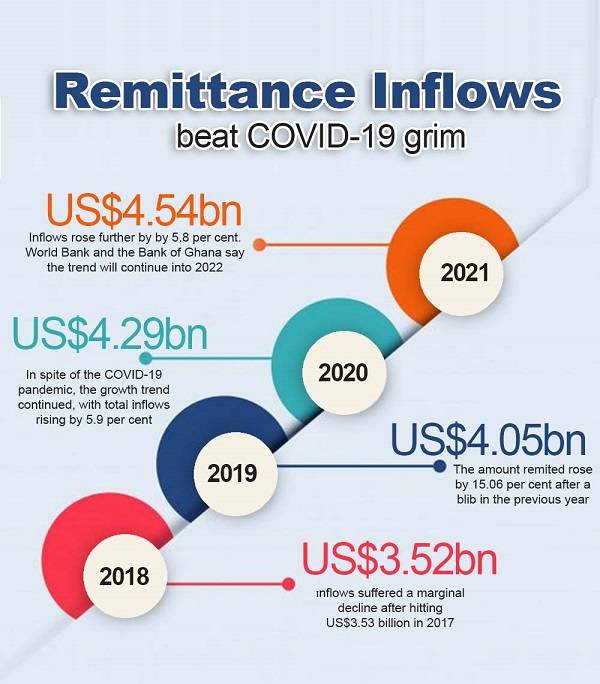Despite the devastating COVID-19 outbreak that destroyed companies and corroded people's earnings throughout the world, GHANA emerged as the leading recipient of remittance inflows in the previous two years.
In 2020 and 2021, remittances to the country grew steadily as more individuals outside the country took advantage of the pandemic's silver lining to send more money home to their families and friends.
Remittance inflows totaled $4.05 billion in 2019, according to data from the World Bank and the Bank of Ghana (BoG), but increased by 5.9% to $4.29 billion in 2020, the first full year of the COVID-19 epidemic.
According to the World Bank's Migration and Development Brief issued this month, remittances to the nation increased by 5.8% to $4.54 billion last year.
Optimistic outlook
Experts attribute the steady increase in remittances to Ghana during the pandemic to the countercyclical nature of the gifting culture, the presence of most Ghanaian non-resident workers in their host countries' health and social services sectors, and the distribution of unemployment benefits to COVID-19 victims.
With the World Bank currently predicting that remittance inflows to low- and middle-income countries (LMICs), including Ghana, will rise by 4.2 percent this year, more money will likely be sent to the nation to assist family and friends.
The Bank of Japan has previously stated that it expects the growth trajectory to continue this year as the global economy resumes its upward trajectory, with restrictions loosened and life returning to normal.
Implications
Prof. Peter Quartey, an economist, told the Graphic Business on June 14 that rising remittance inflows were helpful for the economy since they bolstered the country's reserve position.
Reserves are the assets of the Bank of Ghana, which are used by the central bank to pay for goods and services purchased by the country from its peers.
It also acts as a hedge against the devaluation of the cedi.
Given the benefits, Prof. Quartey, Director of the University of Ghana's Institute for Statistical, Social, and Economic Research (ISSER), stated the increased remittance inflows helped to buffer the country from the pandemic's destructive impacts.
"Investments are made with remittance inflows." Some individuals send money home to invest, others to send money home to pay for school, while yet others send money home to pay for the medical expenditures of their relatives and friends.
"When remittance inflows increase, it implies that various sectors, such as education, health, and investment, gain," stated ISSER's Director.
"It also evens out household expenditures." People send money to their relatives to help them feed. As a result, remittance inflows play a larger role in the economy, and their growth adds to economic growth.
Reasons for expansion
Remittance inflows to Ghana have reached an all-time high of $4.54 billion for 2021, according to World Bank statistics, after starting at $6 million in 1990.
Prof. Quartey said that remittances tended to be countercyclical, which accounted for the consistent rise in inflows despite the pandemic's devastation.
"When there are shocks, they escalate." People are more compassionate through economic shocks, tragedies, or general hardships, and they remit more to their relatives to assist lessen the pain.


